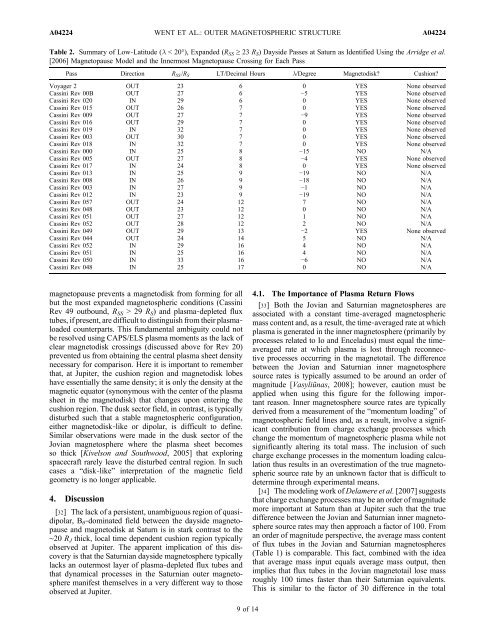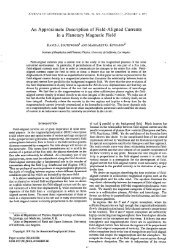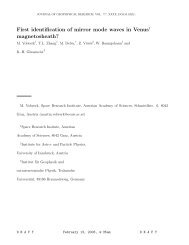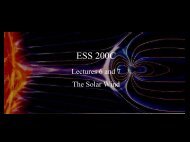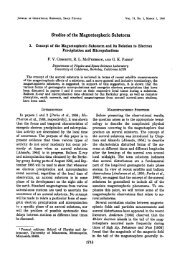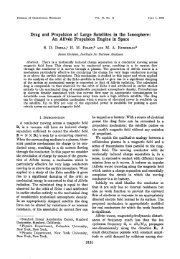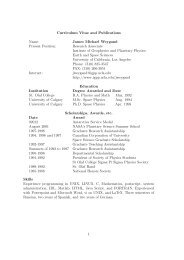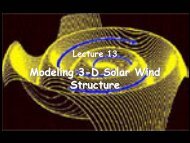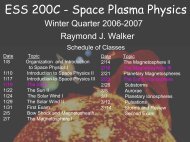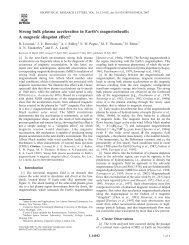Outer magnetospheric structure: Jupiter and Saturn compared
Outer magnetospheric structure: Jupiter and Saturn compared
Outer magnetospheric structure: Jupiter and Saturn compared
Create successful ePaper yourself
Turn your PDF publications into a flip-book with our unique Google optimized e-Paper software.
A04224<br />
WENT ET AL.: OUTER MAGNETOSPHERIC STRUCTURE<br />
A04224<br />
Table 2. Summary of Low‐Latitude (l < 20°), Exp<strong>and</strong>ed (R SS ≥ 23 R S ) Dayside Passes at <strong>Saturn</strong> as Identified Using the Arridge et al.<br />
[2006] Magnetopause Model <strong>and</strong> the Innermost Magnetopause Crossing for Each Pass<br />
Pass Direction R SS /R S LT/Decimal Hours l/Degree Magnetodisk? Cushion?<br />
Voyager 2 OUT 23 6 0 YES None observed<br />
Cassini Rev 00B OUT 27 6 −5 YES None observed<br />
Cassini Rev 020 IN 29 6 0 YES None observed<br />
Cassini Rev 015 OUT 26 7 0 YES None observed<br />
Cassini Rev 009 OUT 27 7 −9 YES None observed<br />
Cassini Rev 016 OUT 29 7 0 YES None observed<br />
Cassini Rev 019 IN 32 7 0 YES None observed<br />
Cassini Rev 003 OUT 30 7 0 YES None observed<br />
Cassini Rev 018 IN 32 7 0 YES None observed<br />
Cassini Rev 000 IN 25 8 −15 NO N/A<br />
Cassini Rev 005 OUT 27 8 −4 YES None observed<br />
Cassini Rev 017 IN 24 8 0 YES None observed<br />
Cassini Rev 013 IN 25 9 −19 NO N/A<br />
Cassini Rev 008 IN 26 9 −18 NO N/A<br />
Cassini Rev 003 IN 27 9 −1 NO N/A<br />
Cassini Rev 012 IN 23 9 −19 NO N/A<br />
Cassini Rev 057 OUT 24 12 7 NO N/A<br />
Cassini Rev 048 OUT 23 12 0 NO N/A<br />
Cassini Rev 051 OUT 27 12 1 NO N/A<br />
Cassini Rev 052 OUT 28 12 2 NO N/A<br />
Cassini Rev 049 OUT 29 13 −2 YES None observed<br />
Cassini Rev 044 OUT 24 14 5 NO N/A<br />
Cassini Rev 052 IN 29 16 4 NO N/A<br />
Cassini Rev 051 IN 25 16 4 NO N/A<br />
Cassini Rev 050 IN 33 16 −6 NO N/A<br />
Cassini Rev 048 IN 25 17 0 NO N/A<br />
magnetopause prevents a magnetodisk from forming for all<br />
but the most exp<strong>and</strong>ed <strong>magnetospheric</strong> conditions (Cassini<br />
Rev 49 outbound, R SS >29R S ) <strong>and</strong> plasma‐depleted flux<br />
tubes, if present, are difficult to distinguish from their plasmaloaded<br />
counterparts. This fundamental ambiguity could not<br />
be resolved using CAPS/ELS plasma moments as the lack of<br />
clear magnetodisk crossings (discussed above for Rev 20)<br />
prevented us from obtaining the central plasma sheet density<br />
necessary for comparison. Here it is important to remember<br />
that, at <strong>Jupiter</strong>, the cushion region <strong>and</strong> magnetodisk lobes<br />
have essentially the same density; it is only the density at the<br />
magnetic equator (synonymous with the center of the plasma<br />
sheet in the magnetodisk) that changes upon entering the<br />
cushion region. The dusk sector field, in contrast, is typically<br />
disturbed such that a stable <strong>magnetospheric</strong> configuration,<br />
either magnetodisk‐like or dipolar, is difficult to define.<br />
Similar observations were made in the dusk sector of the<br />
Jovian magnetosphere where the plasma sheet becomes<br />
so thick [Kivelson <strong>and</strong> Southwood, 2005] that exploring<br />
spacecraft rarely leave the disturbed central region. In such<br />
cases a “disk‐like” interpretation of the magnetic field<br />
geometry is no longer applicable.<br />
4. Discussion<br />
[32] The lack of a persistent, unambiguous region of quasidipolar,<br />
B ‐dominated field between the dayside magnetopause<br />
<strong>and</strong> magnetodisk at <strong>Saturn</strong> is in stark contrast to the<br />
∼20 R J thick, local time dependent cushion region typically<br />
observed at <strong>Jupiter</strong>. The apparent implication of this discovery<br />
is that the <strong>Saturn</strong>ian dayside magnetosphere typically<br />
lacks an outermost layer of plasma‐depleted flux tubes <strong>and</strong><br />
that dynamical processes in the <strong>Saturn</strong>ian outer magnetosphere<br />
manifest themselves in a very different way to those<br />
observed at <strong>Jupiter</strong>.<br />
4.1. The Importance of Plasma Return Flows<br />
[33] Both the Jovian <strong>and</strong> <strong>Saturn</strong>ian magnetospheres are<br />
associated with a constant time‐averaged <strong>magnetospheric</strong><br />
mass content <strong>and</strong>, as a result, the time‐averaged rate at which<br />
plasma is generated in the inner magnetosphere (primarily by<br />
processes related to Io <strong>and</strong> Enceladus) must equal the timeaveraged<br />
rate at which plasma is lost through reconnective<br />
processes occurring in the magnetotail. The difference<br />
between the Jovian <strong>and</strong> <strong>Saturn</strong>ian inner magnetosphere<br />
source rates is typically assumed to be around an order of<br />
magnitude [Vasyliũnas, 2008]; however, caution must be<br />
applied when using this figure for the following important<br />
reason. Inner magnetosphere source rates are typically<br />
derived from a measurement of the “momentum loading” of<br />
<strong>magnetospheric</strong> field lines <strong>and</strong>, as a result, involve a significant<br />
contribution from charge exchange processes which<br />
change the momentum of <strong>magnetospheric</strong> plasma while not<br />
significantly altering its total mass. The inclusion of such<br />
charge exchange processes in the momentum loading calculation<br />
thus results in an overestimation of the true <strong>magnetospheric</strong><br />
source rate by an unknown factor that is difficult to<br />
determine through experimental means.<br />
[34] The modeling work of Delamere et al. [2007] suggests<br />
that charge exchange processes may be an order of magnitude<br />
more important at <strong>Saturn</strong> than at <strong>Jupiter</strong> such that the true<br />
difference between the Jovian <strong>and</strong> <strong>Saturn</strong>ian inner magnetosphere<br />
source rates may then approach a factor of 100. From<br />
an order of magnitude perspective, the average mass content<br />
of flux tubes in the Jovian <strong>and</strong> <strong>Saturn</strong>ian magnetospheres<br />
(Table 1) is comparable. This fact, combined with the idea<br />
that average mass input equals average mass output, then<br />
implies that flux tubes in the Jovian magnetotail lose mass<br />
roughly 100 times faster than their <strong>Saturn</strong>ian equivalents.<br />
This is similar to the factor of 30 difference in the total<br />
9of14


